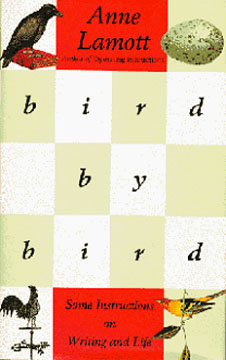
BIRD BY BIRD by Anne Lamott (a book review by L McKenna Donovan) Writing can be a pretty desperate endeavor, because it is about some of our deepest needs: our need to be visible, to be heard, our need to make sense of our lives, to wake up and grow and belong. Bird by Bird: Some Instructions on Writing and Life Humorously on target with the writer s ego, flagrantly down-to-earth and non-apologetic about her language, Anne Lamott provides two basic insights for the writing community that can make those gray writing days a little less chilling. She says: The good news is that some days it feels like you just have to keep getting out of your own way so that whatever it is that wants to be written can use you to write it....But the bad news is that if you re at all like me, you ll probably read over what you ve written and spend the rest of the day obsessing, and praying that you do not die before you can completely rewrite or destroy what you have written, lest the eagerly waiting world learn how bad your first drafts are. Written in four parts, Lamott brings her experience and humor from the blank page through publication letdown. Is there really such a thing as publication letdown? I shall focus on the first two parts, which constitute the major portion of her book: In Part One, Lamott throws two life preservers to the writing community: Short Assignments and Shitty First Drafts. Short Assignments shows us how to eat the proverbial elephant: one bite at a time. When Anne Lamott s younger brother faced an overwhelming report on birds due the next day (he had had three weeks to research and write it), her father leaned over, put a hand on her brother s shoulder, and said, Bird by bird, buddy. Just take it bird by bird. She reminds us to write the next paragraph, the next description. When the words aren t flowing genteelly onto the paper, she urges us to type just one paragraph . Maybe you can describe your character s home town or show them coming out onto their porch (don t worry about the expression on their face yet.) But just get that next tiny bit. The bottom line is to not sit down with the intention of writing a novel and stare at the blank page until beads of blood appear on your forehead, but to sit down with the intention of writing just that next bit. Shitty First Drafts - here Lamott reminds us that shitty first drafts become good second drafts which in turn, become terrific third drafts. I had to laugh when she stated that Not one of [the great writers] writes elegant first drafts. All right, one of them does, but we do not like her very much. We do not think she has a rich inner life or that God likes her or can even stand her. Do any of you have that feeling about Stephen King? Hmmmm... In Part Two, she describes The Writing Frame of Mind, in which she pointedly asserts that writing is about learning to pay attention and to communicate what s going on. Using vignettes from her own childhood, she expresses how a writer s point of view (no, not first-person POV versus third-person omniscient) influences how our readers view our characters. It s easy to look at a cute baby and make your reader love it, but until you can look at your antagonist, and see this character as a living, breathing human being, your readers will not care what happens and they will put the book down. Listen to your broccoli, and your broccoli will tell you how to eat it. Insane advice? Not really. She s telling us to listen to the irrational voice inside, to let that piece of our creative psyche to put down actions, thoughts and dialogue without concern to its rationality. Remember the shitty first draft? Write now edit later. Rich, heartwarming, funny and full of great writing advice for all of us.
© 2001 L McKenna Donovan |